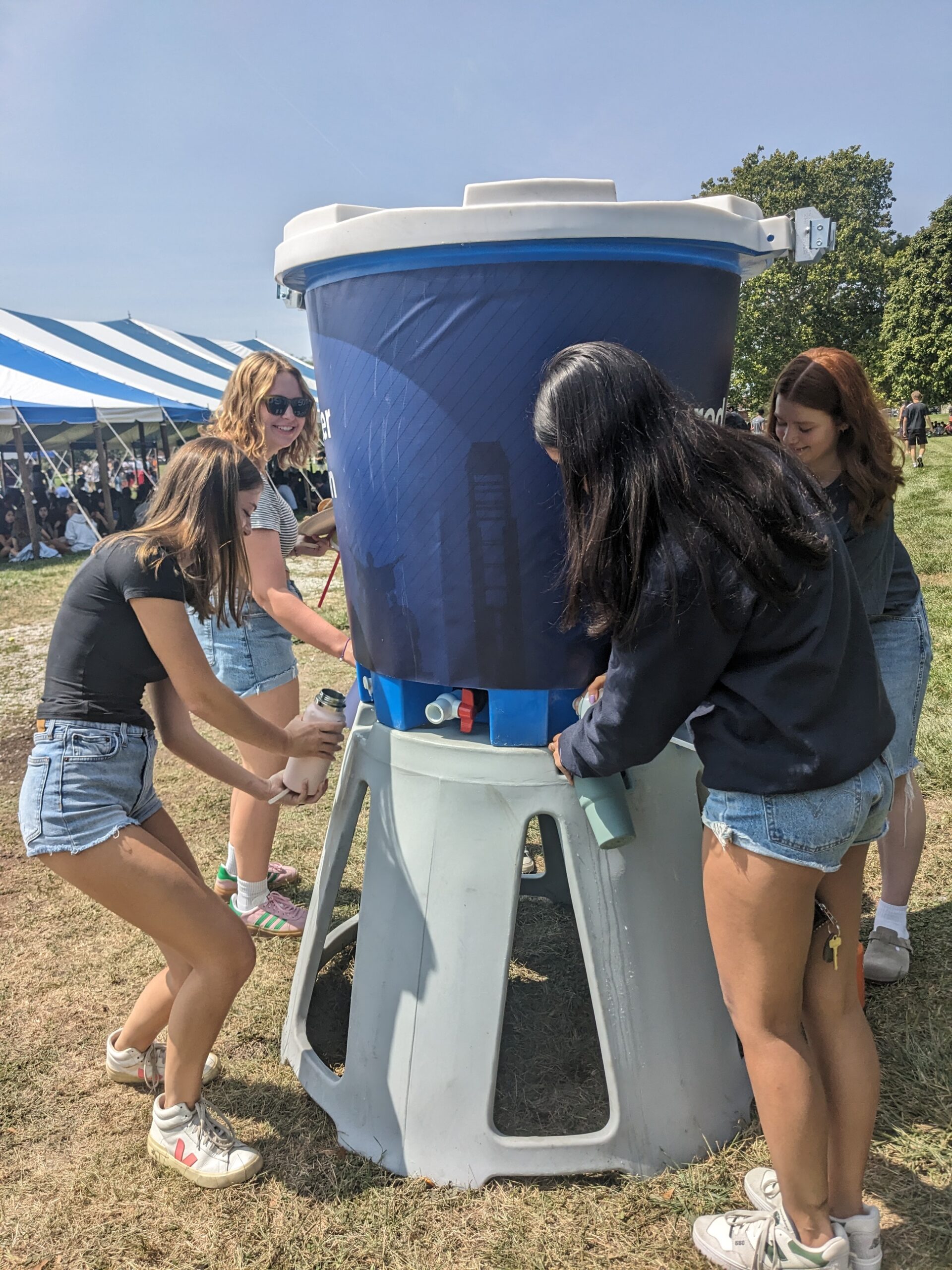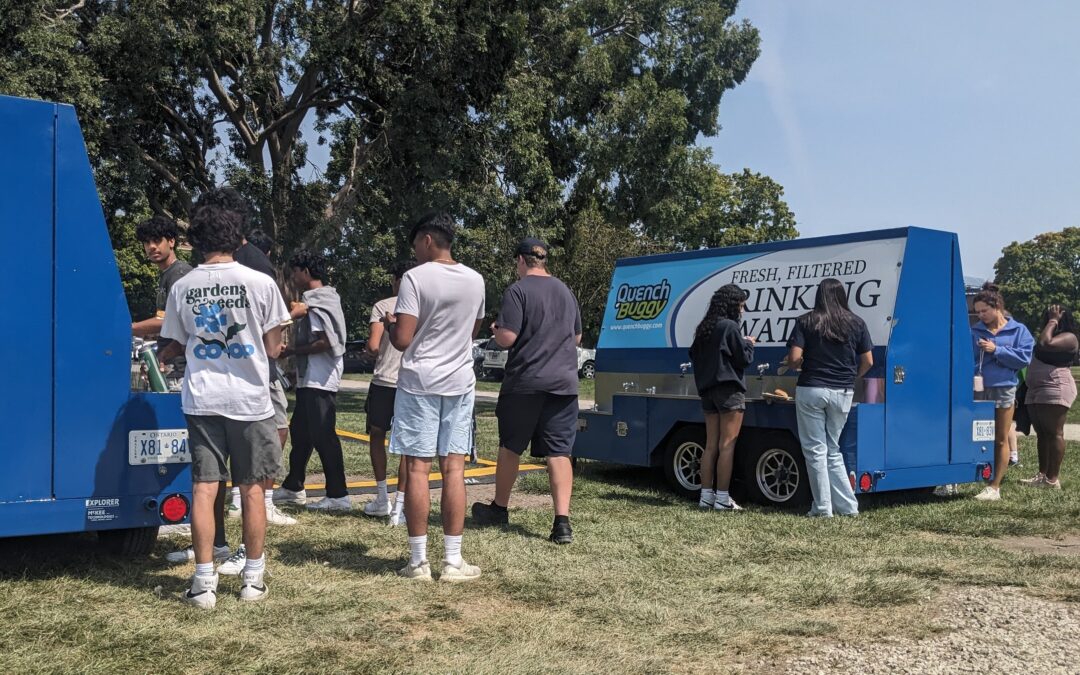In August, the University of Illinois welcomed the Class of 2028 — more than 9,000 students strong. Thanks to Zero Waste efforts championed by iSEE and its campus partners, this record freshman class started the semester off sustainably during events like the New Student Convocation Welcome Celebration and the Quest for Success.
To help achieve objectives prescribed in the Illinois Climate Action Plan (iCAP), iSEE has been identifying areas around campus to decrease waste and increase overall sustainability. “We first look at campus data where large amounts of waste are generated. Then we work with our partners to figure out what solutions are possible and work best for our campus,” iSEE Sustainability Coordinator Miriam Keep said. “Partnerships make all of this happen.”
In what was a typical sweltering August, water accessibility was a top priority. On Friday, Aug. 23, Student Affairs’ New Student & Family Experiences (NSFE) office hosted a Welcome Celebration, directly after the New Student Convocation.
Thousands of new Illini flocked over to Lot 31 where, during any normal year, thousands of plastic water bottles would have been chilling, ready to be used once and then discarded. This year, leading up to the Welcome Celebration, NSFE coordinated with resident advisors to remind freshmen to bring reusable water bottles to the event in order to cut down on plastic waste.
Around Lot 31, various water tanks — branded as “WaterMonsters” and “Quench Buggys” and provided by the Department of Intercollegiate Athletics (DIA) and Student Affairs — dotted the grass. The WaterMonsters — six feet tall with a 125-gallon capacity — only filled up water containers that were either reusable or recyclable. Any student who arrived at the Welcome Celebration without a reusable container was given a recyclable aluminum container provided by Coca-Cola, a longtime campus partner in promoting recycling efforts.
“The iCAP recognizes that pursuing zero waste demands more than just recycling,” F&S Zero Waste Coordinator Daphne Hulse said. “Our programs to eliminate unnecessary waste at large events reflect that philosophy.”
Even after the students were dismissed, college by college, and all the recyclables had been collected, can by can, one WaterMonster was reused at the next day’s Quest for Success — a scavenger hunt-like event that familiarizes new students with campus resources. During that event, the WaterMonster provided a concrete example of reducing waste directly next to iSEE’s station.

Top: Students at the August Welcome Celebration fill up their reusable water bottles at the ‘Quench Buggies.’ Above: Students make use of a ‘Water Monster’ station. Credits: Miriam Keep/iSEE
The WaterMonster also paired nicely with the QR code sticker given out by iSEE at Quest for Success which links to a map of more than 700 refillable bottle “hydration stations” around campus. The map, updated recently by Facilities & Services (F&S), reflects a longtime relationship with iSEE and a commitment to reducing plastic waste and improving campus sustainability.
“The data tell us one of the biggest sources of single-use plastic on campus is water bottles,” Hulse said. “We inventoried all campus facilities and recently upgraded our map identifying where water filler stations are available to an increasingly user-friendly interface.”
Soon, new students staying in older housing will also see hydration stations pop up right at their doorstep. Partnering with University Housing, iSEE was awarded a grant from the Student Sustainability Committee (SSC) to install more than new 50 filling stations in residence halls across campus.
“A lot of our newly renovated residence halls like ISR have plenty of these filling stations,” Keep said. “This way, older facilities can have those as well. We want to make it easy for all students to choose reusable water bottles over disposable ones.”
After Welcome Week and into the first week of classes, all eyes turned to Memorial Stadium for the Fighting Illini’s first football game of the season against Eastern Illinois University (EIU). As it happens, it was also the first football game in the stadium’s 100-year history where you could take any empty reusable water bottle into the stands with you. Previously, only clear bottles were allowed.
According to F&S, gameday refuse adds up to 20 tons of waste into the campus system, with most of it being recyclables. That’s why DIA’s efforts to increase the amount of recycling bins around the State Farm Center and Lot 31 — any tailgater’s dream — mark another sustainable victory in its partnership with iSEE to reduce waste as part of the iCAP.
DIA will team up with iSEE and F&S again this season for more Zero Waste tailgates, hoping to surpass the 2,560 pounds of recyclables collected last year. Further down the line, iSEE has helped DIA set even bigger sustainability goals.
“What we hope to get to in the future is that we won’t have to do as many Zero Waste events because it’ll just be automatic for people,” Senior Associate Athletics Director Marty Kaufmann recently told iSEE. “Over the course of several years, we’ll be able to be in a place where we’ll have our fans trained for recycling and sustainability that Zero Waste events are truly every day.”
As iSEE celebrates Sustainability Month and begins to draft a new version of the iCAP in 2025, recognizing these successes toward campus Zero Waste objectives is paramount. Cross-campus collaboration, consistent messaging, and individual efforts are integral to establishing a “culture of zero waste” — from the university’s largest departments all the way down to each one of the 9,000 new Illini.
— Article by iSEE Communications Associate Gabe Lareau
